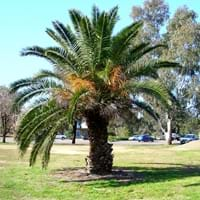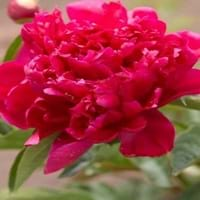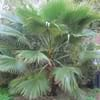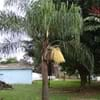Life Span
Perennial
Perennial
Type
Palm or Cycad
Perennial
Origin
Canary Islands
Hybrid origin
Types
phoenix canariensis hybrid, Phoenix rupicola
Aristocrat, Buckeye Belle, Henry Bockstoce , Abalone Pearl, Coral Supreme, Cytherea, Charlie's White
Habitat
along watercourse, Fertile bottom land, Moist Soils, Volcanic Islands
Hillside, Woods
USDA Hardiness Zone
8-13
Not Available
Sunset Zone
H1, H2, 8, 9, 12, 13, 14, 15, 16, 17, 18, 19, 20, 21, 22, 23, 24
Not Available
Habit
Upright/Erect
Clump-Forming
Flower Color
Yellow, Ivory
Not Available
Flower Color Modifier
Bicolor
Bicolor
Fruit Color
Yellow, Red
Not Available
Leaf Color in Spring
Blue Green, Dark Green
Not Available
Leaf Color in Summer
Blue Green, Dark Green
Not Available
Leaf Color in Fall
Blue Green, Dark Green
Not Available
Leaf Color in Winter
Blue Green, Gray Green, Dark Green
Light Green
Leaf Shape
Palmate
Compound
Plant Season
Spring, Summer, Fall, Winter
Spring, Summer
Sunlight
Full Sun, Partial Sun
Full Sun, Partial Sun, Partial shade
Type of Soil
Loam, Sand
Clay, Loam
The pH of Soil
Acidic, Neutral, Alkaline
Acidic, Neutral, Alkaline
Soil Drainage
Well drained
Average
Bloom Time
Early Summer, Summer
Not Available
Tolerances
Drought, Salt
Drought
Where to Plant?
Ground, Pot
Ground, Pot
How to Plant?
Rooted stem cutting, Seedlings
Grafting, Seedlings, Stem Planting, Transplanting
Plant Maintenance
Medium
Medium
Watering Requirements
Allow to dry out slightly between watering, Do Not over Water, Needs good drainage, Reduce watering in winter
Does not require lot of watering, It cannot sustain wet-feet, Keep the ground moist but not water-logged, Needs watering once a week, Prefer drip-irrigation instead of Over-head watering, Water occasionally
In Summer
Lots of watering
Lots of watering
In Spring
Moderate
Moderate
In Winter
Average Water
Average Water
Soil pH
Acidic, Neutral, Alkaline
Acidic, Neutral, Alkaline
Soil Type
Loam, Sand
Clay, Loam
Soil Drainage Capacity
Well drained
Average
Sun Exposure
Full Sun, Partial Sun
Full Sun, Partial Sun, Partial shade
Pruning
Remove damaged leaves, Remove dead branches, Remove dead leaves
Do not prune during shooting season, Prune to control growth, Remove dead or diseased plant parts, Remove deadheads
Fertilizers
All-Purpose Liquid Fertilizer
All-Purpose Liquid Fertilizer
Pests and Diseases
Palmetto weevil
Botrytis Blight, Leaf spot, Stem spot, Viruses
Plant Tolerance
Drought
Drought
Flower Petal Number
Single
Not Available
Foliage Texture
Coarse
Not Available
Foliage Sheen
Glossy
Not Available
Attracts
Not Available
Ants
Allergy
Mild Allergen
Not Available
Aesthetic Uses
Cottage Garden, Formal Garden, Used in parkland
Beautification, Bouquets, Showy Purposes, Used for decorating walls, fences, gates, hedges, etc.
Beauty Benefits
Not Available
Not Available
Environmental Uses
Air purification
Air purification
Medicinal Uses
Energy
Cough, Gout, Headache, Heartburn, Kidney problems, Upset stomach, Urinary tract problems
Part of Plant Used
Whole plant
Flowers, Root, Seeds
Other Uses
Air freshner, Food for insects, Used As Food
Showy Purposes, Used as Ornamental plant, Used for fragrance
Used As Indoor Plant
Yes
No
Used As Outdoor Plant
Yes
Yes
Garden Design
Feature Plant, Fruit / Fruit Tree, Street Trees, Tropical
Cutflower, Feature Plant, Foundation, Mixed Border
Botanical Name
PHOENIX canariensis
PAEONIA 'Rachel'
Common Name
Canary Island Date Palm, canary date palm, dattier des Canaries, phoenix palm, pineapple palm
Intersectional Peony
In Hindi
Phoenix Canariensis
Intersectional Peony
In German
Phoenix Canariensis
Intersectional Pfingstrose
In French
dattier des Canaries
intersectionnelle Pivoine
In Spanish
palmera canaria
interseccional Peony
In Greek
Phoenix Canariensis
διατομεακές Παιώνια
In Portuguese
Palmeira-das-canárias
interseccional Peony
In Polish
Daktylowiec kanaryjski
międzysegmentowe Piwonia
In Latin
Phoenix Canariensis
Intersectional AGLAOPHOTIS
Phylum
Vascular plant
Tracheophyta
Class
Liliopsida
Magnoliopsida
Order
Arecales
Saxifragales
Family
Arecaceae
Paeoniaceae
Clade
Angiosperms, Commelinids, Monocots
Angiosperms, Core eudicots, Eudicots
Tribe
Phoeniceae
Not Available
Subfamily
Coryphoideae
Not Available
Importance of Phoenix Canariensis and Intersectional Peony
Want to have the most appropriate plant for your garden? You might want to know the importance of Phoenix Canariensis and Intersectional Peony. Basically, these two plants vary in many aspects. Compare Phoenix Canariensis and Intersectional Peony as they differ in many characteristics such as their life, care, benefits, facts, etc. Every gardener must at least have the slightest clue about the plants he wants to plant in his garden. Compare their benefits, which differ in many ways like facts and uses. The medicinal use of Phoenix Canariensis is Energy whereas of Intersectional Peony is Cough, Gout, Headache, Heartburn, Kidney problems, Upset stomach and Urinary tract problems. Phoenix Canariensis has beauty benefits as follows: Not Available while Intersectional Peony has beauty benefits as follows: Not Available.
Compare Facts of Phoenix Canariensis vs Intersectional Peony
How to choose the best garden plant for your garden depending upon its facts? Here garden plant comparison will help you to solve this query. Compare the facts of Phoenix Canariensis vs Intersectional Peony and know which one to choose. As garden plants have benefits and other uses, allergy is also a major drawback of plants for some people. Allergic reactions of Phoenix Canariensis are Mild Allergen whereas of Intersectional Peony have Not Available respectively. Having a fruit bearing plant in your garden can be a plus point of your garden. Phoenix Canariensis has showy fruits and Intersectional Peony has no showy fruits. Also Phoenix Canariensis is not flowering and Intersectional Peony is flowering. You can compare Phoenix Canariensis and Intersectional Peony facts and facts of other plants too.





